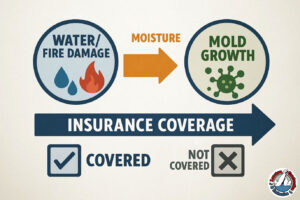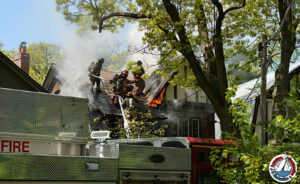Understanding Dangerous Molds – Five Types That Can Harm You

Mold can be dangerous, yet many people make the mistake of underestimating the threat it poses. Let’s take a look at types of molds that can harm people.
On the surface, mold doesn’t look particularly threatening. Sure, it can put off a nasty odor, and it isn’t particularly attractive, but you might not think of it as a life-threatening growth. That’s exactly what it can be, however, so it needs to be treated with respect.
In this article, we’d like to take a closer look at some of the dangerous types of molds that you may encounter in your home or another building. Some molds are more dangerous than others, but without the experience and knowledge necessary to be sure of the differences, it’s always best to treat any kind of mold you find in your home as dangerous. If you find mold, play it safe and contact a professional team like Lawton to address the issue for you.
Types of Molds and the Threat They Present

You don’t need to be an expert on molds to stay healthy. As mentioned above, if you encounter an unexpected mold in your home, the best option is to simply call for professional help.
With that said, we would like to present a basic outline of some of the dangerous types of molds that may be encountered in certain situations.
- Aspergillus fumigatus.
 This is an extremely common type of fungus. In fact, this fungus can be found just about anywhere, making it easy for humans to encounter it in various situations. You have probably breathed in some of this fungus today without any ill effects. However, for people who are at a higher risk, or when people are exposed in large doses, this fungus can become a major health concern.
This is an extremely common type of fungus. In fact, this fungus can be found just about anywhere, making it easy for humans to encounter it in various situations. You have probably breathed in some of this fungus today without any ill effects. However, for people who are at a higher risk, or when people are exposed in large doses, this fungus can become a major health concern. - Black mold
 Rather than defining one specific type of mold, the term “black mold” refers to many different forms. These molds present as black in color, which is where they get their name. While black mold isn’t necessarily any more dangerous than other molds, it is still worthy of your attention. Those in a confined space where black mold is present may deal with symptoms like wheezing and coughing, sore throat, and skin rash, among others. Some of the many types of black mold to be concerned with include ulocladium, Cladosporium, penicillum, aspergillus, and phoma.White mold. Just as there are many types of molds that appear black in color, there are also plenty of molds that are white. If you spot white mold, don’t assume that it is any less dangerous than black mold – it should be given the same respect and treated just as carefully by a professional team.
Rather than defining one specific type of mold, the term “black mold” refers to many different forms. These molds present as black in color, which is where they get their name. While black mold isn’t necessarily any more dangerous than other molds, it is still worthy of your attention. Those in a confined space where black mold is present may deal with symptoms like wheezing and coughing, sore throat, and skin rash, among others. Some of the many types of black mold to be concerned with include ulocladium, Cladosporium, penicillum, aspergillus, and phoma.White mold. Just as there are many types of molds that appear black in color, there are also plenty of molds that are white. If you spot white mold, don’t assume that it is any less dangerous than black mold – it should be given the same respect and treated just as carefully by a professional team. - White mold.
 Just as there are many types of molds that appear black in color, there are also plenty of molds that are white. If you spot white mold, don’t assume that it is any less dangerous than black mold – it should be given the same respect and treated just as carefully by a professional team.
Just as there are many types of molds that appear black in color, there are also plenty of molds that are white. If you spot white mold, don’t assume that it is any less dangerous than black mold – it should be given the same respect and treated just as carefully by a professional team. - Blue mold
 A growth of blue mold in your home is sure to grab your attention. Water damage is commonly a cause of this kind of mold growth, and you may be surprised to find that black mold can eventually take over an area of blue mold given the necessary time. Again here, there is inherent danger with blue mold growth inside of a building, so prompt remediation is important.
A growth of blue mold in your home is sure to grab your attention. Water damage is commonly a cause of this kind of mold growth, and you may be surprised to find that black mold can eventually take over an area of blue mold given the necessary time. Again here, there is inherent danger with blue mold growth inside of a building, so prompt remediation is important. - Green mold.
 To wrap up our list, we are going to touch on green mold – yet another shade in this family. Green mold can be a little tricky because there are plenty of other natural things that grow and are green in color. So, you might be tempted to think of green mold as being less serious than other colors because it doesn’t look as startling in your home. Don’t make that mistake. It can still be dangerous, and it should still be removed properly.
To wrap up our list, we are going to touch on green mold – yet another shade in this family. Green mold can be a little tricky because there are plenty of other natural things that grow and are green in color. So, you might be tempted to think of green mold as being less serious than other colors because it doesn’t look as startling in your home. Don’t make that mistake. It can still be dangerous, and it should still be removed properly.
How Does Mold Appear?
The growth of mold is something of a mystery to many homeowners. While mold can sometimes grow in the aftermath of a major catastrophic event – like a storm damaging a building – it doesn’t always happen that way. Sometimes, it will seem like nothing at all is wrong with a structure, and yet mold will still appear.
To understand how mold appears, you need to understand a few basic things about mold. First, like virtually all living things, mold likes water. In the absence of water, you won’t need to worry about mold developing. It should be noted, however, that mold doesn’t necessarily need a lot of water to grow, so even a small leak could be more than enough to jumpstart mold growth.
While mold loves water, it does not like ventilation or sunlight. Areas that are well-ventilated and get plenty of air movement are not likely candidates for mold issues. Likewise, any area that regularly gets a lot of sun is very unlikely to see mold. This is why buildings most often have mold develop in places like basements or inside cabinets. These are areas that don’t get any direct sunlight.
Getting Rid of Mold with Home Remedies
So, you have found mold in your home, and you’d like to get rid of it as soon as possible. At this point, it is tempting to take on the problem yourself, simply doing a little DIY work to eliminate the mold. On this point, there is good news and bad news. The good news is that you should be able to get rid of the mold relatively easily with one of a few methods. On the downside, that success is likely to be temporary, and the mold will be back sooner than later.
As far as techniques are concerned, there are a variety of products you can apply to mold to remove it. A solution of vinegar and a small amount of hydrogen peroxide is a popular method, as is diluting bleach in water and spraying it on. Unfortunately, no matter which method you choose, the long-term outcome is likely to be the same.
Here’s the problem – simply cleaning up the mold growth doesn’t do anything to solve the underlying issue. What caused the mold to start growing in the first place? That’s the issue that needs to be solved, along with having the necessary cleanup performed. Without taking care of the true cause of the mold, you’ll be dealing with this problem repeatedly. A professional remediation team can not only do a thorough cleaning of the affected area, but that team can also determine why mold is growing and what can be done to stop it.
Is Moldy Cheese Safe?

The kinds of mold that grow on certain cheeses are edible, and even considered a delicacy. With that said, it’s important to note that not all mold that grows on cheese is something you would want to eat. For example, cheeses like Roquefort, muenster, and brie are all commonly associated with mold. If you find those types of cheeses in your local grocery store, they may be expected to mold as they age.
That’s not the same story as something like a block of standard cheddar cheese that has been sitting in your refrigerator too long. In that case, you’d want to throw out the old cheese and replace it.
Getting Professional Help

When facing mold, the best thing you can do is turn to a professional team like Lawton Construction & Restoration. We offer professional mold removal services, and we also have the services available to rebuild any affected areas of the building that may need to be demolished to eliminate the mold problem.
Don’t spend any more time trying to decide how you are going to approach this issue. Instead, pick up the phone and call Lawton today to get started. We will be happy to provide you with a free estimate on our services, and we can discuss the process with you to make sure all your questions are answered. Don’t go down the road or trying to handle this problem yourself, and certainly don’t sit back and hope that the problem will go away. Contact us right away and let’s get started.
Who We Are
Lawton Construction & Restoration. Proudly serving in North California & Nevada since 1976.
Turnkey services: Emergency, Restoration, Content Care
All levels of complexity: Residential, Comercial, Industrial
Fast interaction with all insurance companies.



